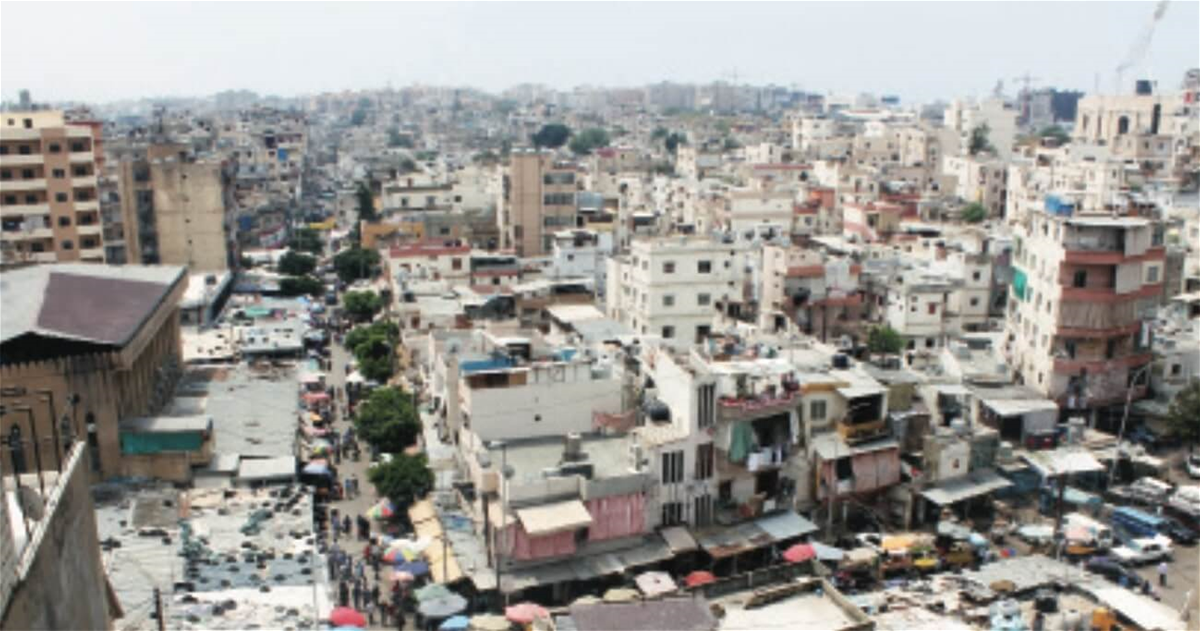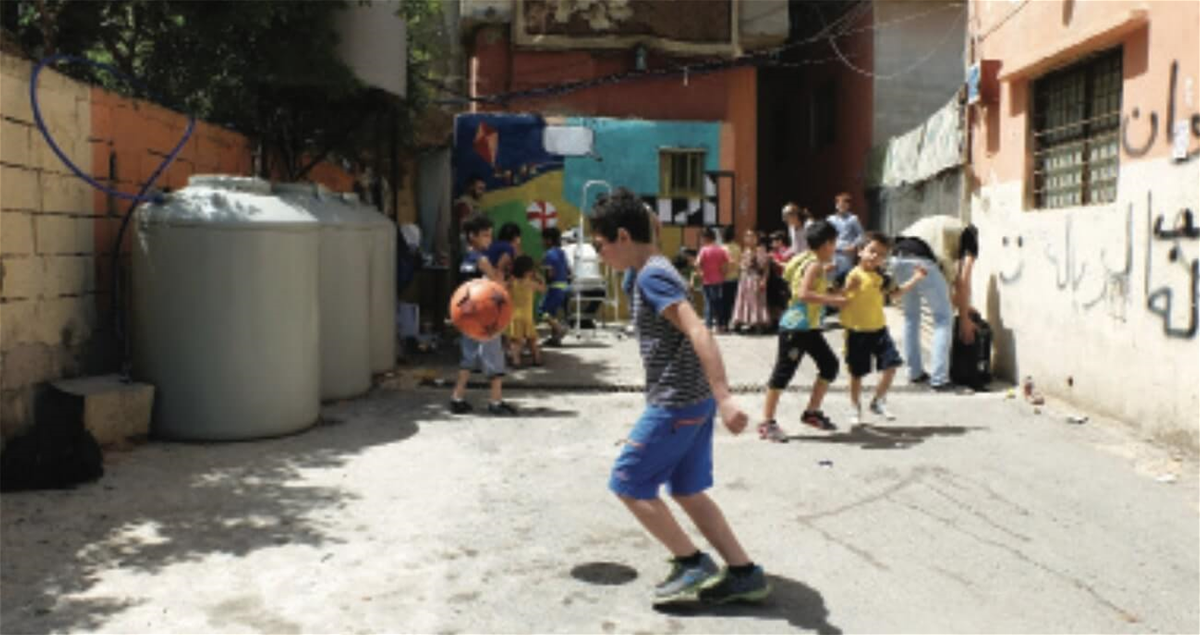That was what Umm Mohammad told us when we met with her. Perhaps the conversation was far removed from the idea in the beginning, but it is the tale of the Palestinians who leave every place as they wait for their return to Palestine that resurfaces in all images and scenes. This long wandering journey, which is nothing short of the famous Greek mythologies, makes any words used pale in comparison to the actual daily life of Palestinians. It is the tale of Umm Mohammad who has come from the Nayrab camp in Syria with her family of five to live in the Lebanese capital Beirut, and specifically in the «Said Ghawash» Palestinian gathering, as they are referred to in Arabic (located behind the Sports City stadium). This small gathering – to this day not considered a camp under any legal or social provision – includes roughly 225 Palestinian/Lebanese/Syrian households (and Syrian Palestinian) and has grown according to a UN survey (conducted by UNDP and UNHABITAT in 2014) by 17 percent (roughly 100 households) following the Syrian crisis. One of those households is Umm Mohammad’s family.
Umm Mohammad’s family fills in the blanks of the tale: they had come from Syria under intense shelling and sniping, fleeing to Lebanon since her relatives originally come from this region (since leaving Palestine in 1948). So she could not have found a safer place than here, for she knows the environment and the place, and the relatives would certainly provide a protective shield. Of course, this tale repeats itself with Syrian (or Palestinian Syrian) families that have come following the intensification of the impact of the crisis there. They believed that their relatives here would «host» them until what they believed would be a prompt return to «Syria», for example. Many had not visited Lebanon before and some did not even know that they had relatives in this area. But brutal circumstances lead to even harsher ones. Surely migrating to «gatherings» is no happy choice. These gatherings already suffer terribly. Usually, when there is talk of miserable conditions, camps are mentioned as a token and there is talk of the difficulties and hardships of living in camps given the poor development, social and living services – experienced by the majority of Palestinians. But when you see the so-called «gatherings», you understand that even in the concept of living «hardship» comes in degrees and what you thought was harsh in the camps could be «paradise» in other considerations.
These Palestinian gatherings (which by the way number 42 distributed around the capital city and other Lebanese regions – Beqaa, the South, Tripoli – and which include more than 110,000 Palestinians and later upwards of 30,000 Palestinian and Syrian displaced following the Syrian crisis), according to the UNDP project «Improving Living Conditions in Palestinian Gatherings Host Communities», have not come into existence with the Syrian crisis as many tend to think, rather these events have brought them to the fore again. Perhaps this could be a good thing in one way or another as it could improve the lives of both their old and new dwellers. But let’s not forget the other aspect of the issue of course: the «capacities» of these gatherings are limited to begin with, thus this increase in population and numbers could represent a catastrophe in itself. The Fafo Institute for Applied International Studies (2003) defines Palestinian gatherings in Lebanon «as neighborhoods located outside the boundaries of the official camps and where 35 or more Palestinian households live together, constituting relatively homogenous communities». As previously mentioned, they appeared in the beginning in the Nakba year (1948) and later more were formed during the Civil War (1975-1990) as a result of fighting and destruction of some camps and demographic expansion. The «Daouk» gathering, for example, was created when the original property owner Omar Daouk donated the plot in 1952 to the Palestinian people until their return home (a court order confirmed it in 1966). The man obviously did not suspect that the «expatriation» would drag on and that the status quo would remain unchanged for over 60 years.
Gatherings do not receive direct development and social services neither from the Lebanese state nor the UNRWA. According to the UNRWA, gatherings do not fall under the definition of camps and, naturally, are not an «extension» of it because it operates «inside camps» according to the nature of its work and mandate. For its part, the Lebanese state does not see the matter that way. It deals with these areas with a mixture of caution and watchfulness – to be noted that local municipalities that host gatherings are at times not able to provide services for «lack of resources». Electricity, water and health services are basics of normal daily human life and it is not unusual to hear that in 2016 in Lebanon, a country considered to be a Middle Eastern «beacon» of development and civilization, there are households in the capital that have no electricity, no lighting and not even «lighting» poles (or even power poles) nearby to «get light» from! The story may seem fantastical to a large extent, for how could this be? All of this can be witnessed in a visit to one of the gatherings scattered around the capital city: Daouk, Said Ghawash or Gaza building. On another note, these gatherings host besides the Palestinians and the displaced Syrians, families from East Asia, particularly those from Bangladesh and Sri Lanka. This is due to the fact that housing rental prices, which are closer to housing rental prices inside camps, make them «cheap» compared to their Beiruti surroundings that are more expensive to «rent». In addition, prices of «goods» and everyday purchases are obviously less expensive there than in neighboring areas.
In the midst of all of this, the «Improving Living Conditions in Palestinian Gatherings Host Communities» project is being actively implemented. It is a UNDP project, funded by governements of Germany, Switzerland, Japan and the US, that falls under the framework of the Stabilization and Recovery Program launched by UNDP earlier to reinforce stability in communities impacted by the Syrian crisis (from 2013). This program came as a response to help to reinforce these communities in adapting to the huge Syrian migrants crisis following the conflict there. The program covers many aspects that are not covered by anyone else; therefore, it receives much «support» in the local milieu inside these gatherings. What it has provided to date, no one else cares to provide at all. In addition, it represents «care» of sorts for the humanity of those people, the fact which motivates them in one way or another to improve their lives, and thus take care of themselves and those around them more. According to official statistics issued by the UNDP, more than 63 infrastructure projects have been provided through the program as well as 600 houses to displaced Palestinian families from Syria with their rehabilitation and linking them to water and sanitation networks in more than 30 gatherings, not to mention of course more than 350 jobs for Syrian Palestinians who were in dire need of them. In this framework, the hygiene awareness campaign carried out by the project comes as a necessary and important activity to reduce the rate of diseases spreading in such environments and a pre-emptive attempt to prevent them. Thus more than 5,380 hygiene kits have been distributed to displaced families and children as well as 4,000 people have benefited directly from that campaign (according to a 2014 project booklet). Despite these huge and strenuous efforts on the part of the UN team, the project requires more efforts than what it is offering. At the end of the day, the matter requires an international definitive solution for the issue because these gatherings will definitely not be able in any way to «host» this large number of people, especially seeing that the number of displaced people may increase with the indefinite future of the Syrian crisis.

